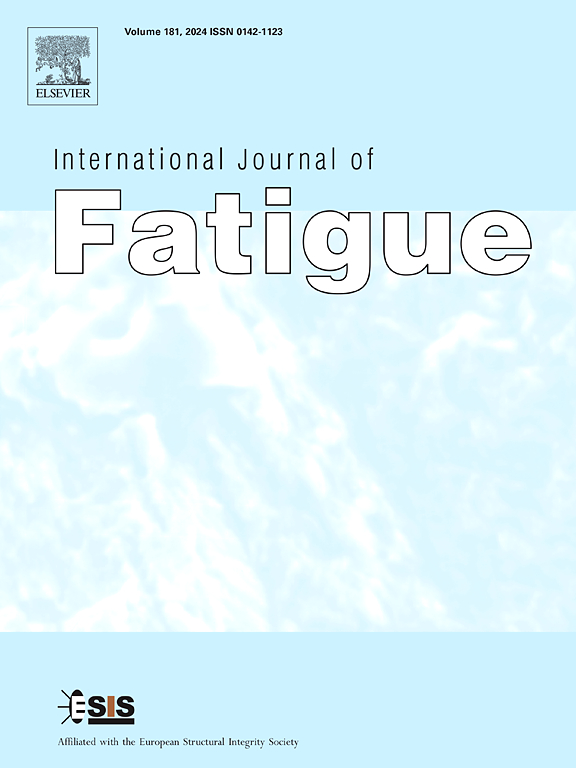Fretting fatigue damage and crack propagation of shot-peening dovetail joints assisted with the U-Net model
IF 5.7
2区 材料科学
Q1 ENGINEERING, MECHANICAL
引用次数: 0
Abstract
This study systematically examines the fretting fatigue behavior of Ti-6Al-4 V dovetail joints with and without shot-peening (SP) treatment, focusing on crack initiation, propagation mechanisms, and SP-induced microstructural modifications. An innovative four-camera in situ observation system was developed to track real-time crack evolution at four critical locations of the dovetail tenon. Integrated with deep learning-based U-Net models for crack segmentation and length quantification, the effects of SP treatment on fretting fatigue life, crack propagation rates, and surface damage were analyzed under varying loads (26–40 kN). The results demonstrate that SP treatment significantly enhances overall fretting fatigue life at low and medium loads (26–34 kN) by delaying crack initiation and early propagation through compressive residual stresses (CRS) and strain hardening, achieving maximum life enhancement of 186.19 % at 26 kN, while proving ineffective in suppressing long-crack growth under cyclic stress superposition. At 40 kN, SP exhibits detrimental effects due to accelerated CRS relaxation and stress concentration induced by surface roughness. Although the initiation life remains superior to untreated specimens, the overall fretting fatigue life decreases due to accelerated crack propagation rates. These findings highlight the dual role of SP in fretting fatigue resistance, emphasizing the necessity of load-dependent optimization strategies for aerospace applications.
基于U-Net模型的喷丸燕尾接头微动疲劳损伤及裂纹扩展
本研究系统地研究了喷丸处理和不喷丸处理的ti - 6al - 4v燕尾接头的微动疲劳行为,重点研究了裂纹的萌生、扩展机制和喷丸诱导的显微组织改变。开发了一种创新的四摄像头现场观测系统,用于实时跟踪燕尾榫四个关键位置的裂纹演变。结合基于深度学习的U-Net模型进行裂纹分割和长度量化,分析了不同载荷(26-40 kN)下SP处理对微动疲劳寿命、裂纹扩展速率和表面损伤的影响。结果表明,SP处理通过压缩残余应力(CRS)和应变硬化延缓裂纹萌生和早期扩展,显著提高了中低载荷(26 - 34 kN)下的微动疲劳总寿命,在26 kN时最大寿命提高了186.19%,但在循环应力叠加下对抑制长裂纹扩展无效。在40 kN时,由于表面粗糙度引起的CRS松弛和应力集中加速,SP表现出不利影响。虽然启动寿命仍优于未经处理的试样,但由于裂纹扩展速度加快,总体微动疲劳寿命降低。这些发现突出了SP在抗微动疲劳中的双重作用,强调了航空航天应用中载荷相关优化策略的必要性。
本文章由计算机程序翻译,如有差异,请以英文原文为准。
求助全文
约1分钟内获得全文
求助全文
来源期刊

International Journal of Fatigue
工程技术-材料科学:综合
CiteScore
10.70
自引率
21.70%
发文量
619
审稿时长
58 days
期刊介绍:
Typical subjects discussed in International Journal of Fatigue address:
Novel fatigue testing and characterization methods (new kinds of fatigue tests, critical evaluation of existing methods, in situ measurement of fatigue degradation, non-contact field measurements)
Multiaxial fatigue and complex loading effects of materials and structures, exploring state-of-the-art concepts in degradation under cyclic loading
Fatigue in the very high cycle regime, including failure mode transitions from surface to subsurface, effects of surface treatment, processing, and loading conditions
Modeling (including degradation processes and related driving forces, multiscale/multi-resolution methods, computational hierarchical and concurrent methods for coupled component and material responses, novel methods for notch root analysis, fracture mechanics, damage mechanics, crack growth kinetics, life prediction and durability, and prediction of stochastic fatigue behavior reflecting microstructure and service conditions)
Models for early stages of fatigue crack formation and growth that explicitly consider microstructure and relevant materials science aspects
Understanding the influence or manufacturing and processing route on fatigue degradation, and embedding this understanding in more predictive schemes for mitigation and design against fatigue
Prognosis and damage state awareness (including sensors, monitoring, methodology, interactive control, accelerated methods, data interpretation)
Applications of technologies associated with fatigue and their implications for structural integrity and reliability. This includes issues related to design, operation and maintenance, i.e., life cycle engineering
Smart materials and structures that can sense and mitigate fatigue degradation
Fatigue of devices and structures at small scales, including effects of process route and surfaces/interfaces.
 求助内容:
求助内容: 应助结果提醒方式:
应助结果提醒方式:


